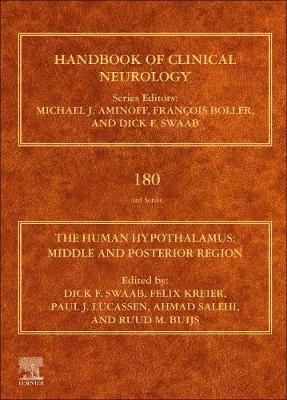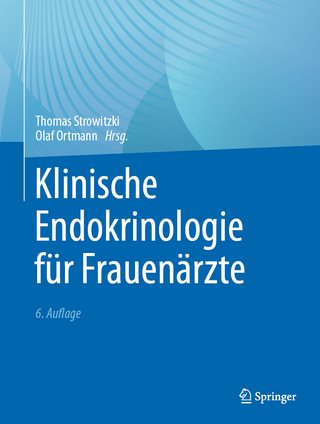
The Human Hypothalamus
Elsevier Science Publishing Co Inc (Verlag)
978-0-12-820107-7 (ISBN)
Dick Swaab (1944) earned his medical and doctoral degrees at the University of Amsterdam, where he became involved in brain research during his third year of medical school. He was Director of the Netherlands Institute for Brain Research from 1978 to 2005. Since 1979 he is Professor of Neurobiology at the Medical Faculty, University of Amsterdam. In 1985, Dr. Swaab founded the Netherlands Brain Bank (NBB) to serve as a source of clinically and neuropathologically well-documented research tissue. Since its founding, the Brain Bank has provided samples from more than 4,000 autopsies to 500 research groups in 25 countries. He was director of the NBB until 2005. He is Leader Research team Neuropsychiatric Disorders, Neth. Inst for Neuroscience, an institute of the Royal Netherlands Academy of Arts and Sciences (KNAW). Swaab is also appointed for 2011-2017 Chao Kuang Piu Chair of Zhejiang University, Hangzhou, P.R. China. His major research interests focus on, sexual differentiation of the human brain in relation to gender identity and sexual orientation, aging of the brain, Alzheimer’s disease, the neurobiological basis of depression, suicide and eating disorders. He has published over 540 papers in SCI journals, authored more than 200 chapters in books, and edited more than 60 books. Swaab mentored 84 PhD students from which 16 are now full professor. He is “Companion in the Order of the Dutch Lion, bestowed by her Royal Majesty Queen Beatrix of the Netherlands. In 2008 Swaab obtained the Academy medal for his role in national and international neuroscience. Dick Swaab is author of the 2 volume monograph The Human Hypothalamus that appeared in the Handbook of Clinical Neurology series, Elsevier, Amsterdam (1000 pp) and the Dutch best seller We are our Brains (450.000 copies sold), that is translated in 14 languages. A children's version of the book (You are your brains) has also appeared in Dutch in 2013 and Russian (2014). Swaab's H-factor is 76. Felix Kreier is a pediatrician and affiliated with OLVG Hospitals in Amsterdam, The Netherlands. Paul J. Lucassen did his PhD in 1995 on Alzheimer’s Disease at the Netherlands Institute for Brain Research in Amsterdam. After a.o. a postdoc in Leiden, he became Full Professor of Brain Plasticity in 2011 at the Swammerdam Institute for Life Sciences (SILS) of the University of Amsterdam, The Netherlands. His group studies molecular, nutritional, pharmacological and environmental regulation of brain plasticity. They combine molecular tools, in vitro/vivo model systems, human brain tissue, cohort studies and brain imaging. A major focus is on adult neurogenesis and cognition in relation to; (early life) stress, exercise, enrichment, depression, brain insults and dementia. Ahmad Salehi is affiliated with Stanford Medical School, Department of Psychiatry & Behavioral Sciences, in Palo Alto, CA, United States. Dr. Ruud M. Buijs is head of the Physiology department of the I.I.Biomedicas at the UNAM university and leader of the group Hypothalamic Integration Mechanisms. In that group, the scientists study how the brain and body interact with each other, and hereby the attention is focussed on autonomic and hormonal regulation of body functions under the influence of the biological clock of the brain.
1. Introduction: The middle and posterior hypothalamus
SECTION 6 Supraoptic and paraventricular nucleus more than a neuroendocrine system
2. Vasopressin and oxytocin beyond the pituitary in the human brain
3. Central and peripheral release of oxytocin: Relevance of neuroendocrine and neurotransmitter actions for physiology and behavior
4. Organization of the neuroendocrine and autonomic hypothalamic paraventricular nucleus
5. Sex differences of oxytocin and vasopressin in social behaviors
6. Oxytocin, eating behavior, and metabolism in humans
7. The supraoptic and paraventricular nuclei in healthy aging and neurodegeneration
8. Perinatal stress and epigenetics
9. The hypothalamus in anxiety disorders
10. Congenital isolated central hypothyroidism: Novel mutations and their functional implications
SECTION 7 Zona incerta
11. The zona incerta system: Involvement in attention and movement
SECTION 8 Ventromedial nucleus and dorsomedial nucleus
12. The role of the dorsomedial and ventromedial hypothalamus in regulating behaviorally coupled and resting autonomic drive
SECTION 9 Circumventricular organs of the hypothalamus
13. The subfornical organ and organum vasculosum of the lamina terminalis: Critical roles in cardiovascular regulation and the control of fluid balance
14. Lamina terminalis fenestration: An important neurosurgical corridor
15. Arcuate nucleus, median eminence, and hypophysial pars tuberalis
16. Tanycytes in the infundibular nucleus and median eminence and their role in the blood–brain barrier
17. The human hypothalamic kisspeptin system: Functional neuroanatomy and clinical perspectives
18. Kisspeptin and neurokinin B expression in the human hypothalamus: Relation to reproduction and gender identity
19. The infundibular peptidergic neurons and glia cells in overeating, obesity, and diabetes
20. Hypothalamus and weight loss in amyotrophic lateral sclerosis
SECTION 10 Lateral tuberal nucleus
SECTION 11 Lateral hypothalamic area, perifornical area
21. The orexin/hypocretin system in neuropsychiatric disorders: Relation to signs and symptoms
22. Pleasure, addiction, and hypocretin (orexin)
SECTION 12 Tuberomamillary complex
23. Histamine receptors, agonists, and antagonists in health and disease
24. The tuberomamillary nucleus in neuropsychiatric disorders
SECTION 13 Subthalamic nucleus
25. Imaging of the human subthalamic nucleus
26. Neuropsychiatric effects of subthalamic deep brain stimulation
27. The subthalamic nucleus and the placebo effect in Parkinson's disease
SECTION 14 Corpora mamillaria, fornix, and mamillothalamic tract
28. Electrical stimulation of the fornix for the treatment of brain diseases
29. The contribution of mamillary body damage to Wernicke's encephalopathy and Korsakoff's syndrome
| Erscheinungsdatum | 06.09.2021 |
|---|---|
| Reihe/Serie | Handbook of Clinical Neurology |
| Sprache | englisch |
| Maße | 195 x 260 mm |
| Gewicht | 1440 g |
| Themenwelt | Medizinische Fachgebiete ► Innere Medizin ► Endokrinologie |
| Medizin / Pharmazie ► Medizinische Fachgebiete ► Neurologie | |
| Naturwissenschaften ► Biologie ► Humanbiologie | |
| Naturwissenschaften ► Biologie ► Zoologie | |
| ISBN-10 | 0-12-820107-X / 012820107X |
| ISBN-13 | 978-0-12-820107-7 / 9780128201077 |
| Zustand | Neuware |
| Informationen gemäß Produktsicherheitsverordnung (GPSR) | |
| Haben Sie eine Frage zum Produkt? |
aus dem Bereich


